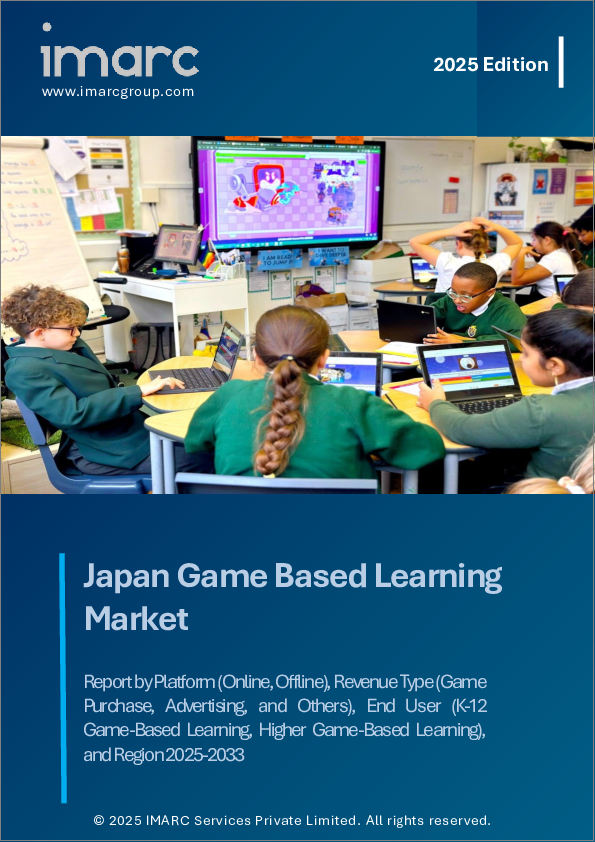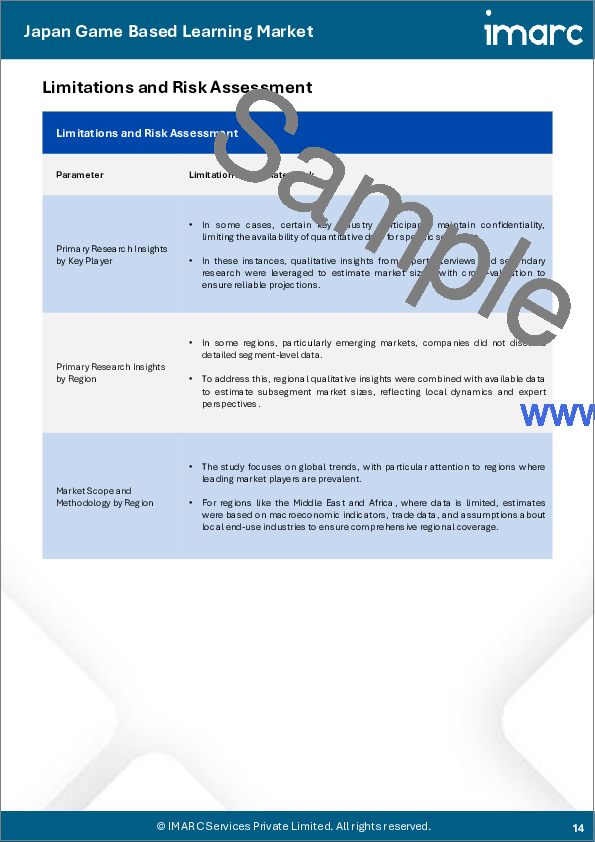|
|
市場調査レポート
商品コード
1729539
日本のゲームベースラーニング市場レポート:プラットフォーム別、収益タイプ別、エンドユーザー別、地域別、2025年~2033年Japan Game Based Learning Market Report by Platform (Online, Offline), Revenue Type (Game Purchase, Advertising, and Others), End User (K-12 Game-Based Learning, Higher Game-Based Learning), and Region 2025-2033 |
||||||
カスタマイズ可能
|
|||||||
| 日本のゲームベースラーニング市場レポート:プラットフォーム別、収益タイプ別、エンドユーザー別、地域別、2025年~2033年 |
|
出版日: 2025年05月01日
発行: IMARC
ページ情報: 英文 118 Pages
納期: 5~7営業日
|
全表示
- 概要
- 目次
日本のゲームベースラーニングの市場規模は2024年に8億7,330万米ドルに達しました。今後、IMARC Groupは、同市場が2033年までに50億3,910万米ドルに達し、2025年から2033年にかけて19.7%の成長率(CAGR)を示すと予測しています。同市場は、より没入感のある学習体験に対するニーズの高まり、教育成果の向上、個別化・適応型学習アプローチ、企業研修やスキル向上への取り組み、スマートフォンの普及など、いくつかの重要な要因によって牽引されています。
本レポートで扱う主な質問
- 日本のゲームベースラーニング市場はこれまでどのように推移し、今後どのように推移するのか?
- COVID-19が日本のゲームベースラーニング市場に与えた影響は?
- 日本のゲームベースラーニング市場のプラットフォーム別区分は?
- 日本のゲームベースラーニング市場の収益タイプ別区分は?
- 日本のゲームベースラーニング市場のエンドユーザー別の区分は?
- 日本のゲームベースラーニング市場のバリューチェーンにおける様々なステージとは?
- 日本のゲームベースラーニングの主な促進要因と課題は何か?
- 日本のゲームベースラーニング市場の構造と主要プレーヤーは?
- 日本のゲームベースラーニング市場における競合の程度は?
目次
第1章 序文
第2章 調査範囲と調査手法
- 調査の目的
- ステークホルダー
- データソース
- 市場推定
- 調査手法
第3章 エグゼクティブサマリー
第4章 日本のゲームベースラーニング市場:イントロダクション
- 概要
- 市場力学
- 業界動向
- 競合情報
第5章 日本のゲームベースラーニング市場情勢
- 過去および現在の市場動向(2019~2024年)
- 市場予測(2025~2033年)
第6章 日本のゲームベースラーニング市場:プラットフォーム別の内訳
- オンライン
- オフライン
第7章 日本のゲームベースラーニング市場: 収益タイプ別の内訳
- ゲームの購入
- 広告
- その他
第8章 日本のゲームベースラーニング市場:エンドユーザー別の内訳
- K-12ゲームベースラーニング
- 高等ゲームベースラーニング
第9章 日本のゲームベースラーニング市場:競合情勢
- 概要
- 市場構造
- 市場企業のポジショニング
- 主要成功戦略
- 競合ダッシュボード
- 企業評価象限
第10章 主要企業のプロファイル
第11章 日本のゲームベースラーニング市場:業界分析
- 促進要因、抑制要因、機会
- ポーターのファイブフォース分析
- バリューチェーン分析
第12章 付録
Japan game based learning market size reached USD 873.3 Million in 2024. Looking forward, IMARC Group expects the market to reach USD 5,039.1 Million by 2033, exhibiting a growth rate (CAGR) of 19.7% during 2025-2033. The market is being driven by several significant factors, including a growing need for more immersive learning experiences, improved educational results, personalized and adaptive learning approaches, corporate training and skill enhancement initiatives, and the increasing prevalence of smartphone use.
Game-based learning is an educational strategy that employs interactive games to facilitate the process of learning and skill acquisition. Within this framework, learners participate in game scenarios and activities that have been specifically designed to align with defined educational goals. By incorporating game elements such as challenges, rewards, and progression, this approach motivates participants to actively engage in the learning journey. The primary objective of game-based learning is to enrich the learning experience by encouraging active participation, honing problem-solving abilities, and fostering critical thinking skills. Through immersion in a dynamic and interactive environment, learners are prompted to explore, experiment, and apply acquired knowledge in real-world contexts. This methodology proves particularly advantageous in deepening comprehension of intricate concepts and promoting knowledge retention. Game-based learning has garnered widespread acclaim across diverse sectors, including formal education, corporate training, and professional development initiatives. Its efficacy is rooted in its capacity to render learning enjoyable and pertinent, ultimately resulting in heightened knowledge retention and enhanced performance outcomes.
Japan Game Based Learning Market Trends:
The game-based learning market in Japan is experiencing notable growth, driven by several key factors. There is an increasing recognition of the benefits of interactive gaming as an educational tool, particularly in enhancing engagement and fostering critical thinking among learners. Additionally, educational institutions, including schools and universities, are incorporating game-based learning methods into their curricula to create dynamic and immersive learning experiences, which is acting as another significant growth-inducing factor. Furthermore, the corporate sector is adopting game-based training programs to enhance employee skills and productivity. Besides this, with the widespread availability of smartphones and digital devices, game-based learning is becoming more accessible and convenient, further fueling its adoption. The market is witnessing innovations in game design and technology to align with educational objectives, making it a valuable component of Japan's educational landscape and professional development initiatives.
Japan Game Based Learning Market Segmentation:
Platform Insights:
- Online
- Offline
Revenue Type Insights:
- Game Purchase
- Advertising
- Others
End User Insights:
- K-12 Game-Based Learning
- Higher Game-Based Learning
Competitive Landscape:
The market research report has also provided a comprehensive analysis of the competitive landscape in the market. Competitive analysis such as market structure, key player positioning, top winning strategies, competitive dashboard, and company evaluation quadrant has been covered in the report. Also, detailed profiles of all major companies have been provided.
Key Questions Answered in This Report:
- How has the Japan game based learning market performed so far and how will it perform in the coming years?
- What has been the impact of COVID-19 on the Japan game based learning market?
- What is the breakup of the Japan game based learning market on the basis of platform?
- What is the breakup of the Japan game based learning market on the basis of revenue type?
- What is the breakup of the Japan game based learning market on the basis of end user?
- What are the various stages in the value chain of the Japan game based learning market?
- What are the key driving factors and challenges in the Japan game based learning?
- What is the structure of the Japan game based learning market and who are the key players?
- What is the degree of competition in the Japan game based learning market?
Table of Contents
1 Preface
2 Scope and Methodology
- 2.1 Objectives of the Study
- 2.2 Stakeholders
- 2.3 Data Sources
- 2.3.1 Primary Sources
- 2.3.2 Secondary Sources
- 2.4 Market Estimation
- 2.4.1 Bottom-Up Approach
- 2.4.2 Top-Down Approach
- 2.5 Forecasting Methodology
3 Executive Summary
4 Japan Game Based Learning Market - Introduction
- 4.1 Overview
- 4.2 Market Dynamics
- 4.3 Industry Trends
- 4.4 Competitive Intelligence
5 Japan Game Based Learning Market Landscape
- 5.1 Historical and Current Market Trends (2019-2024)
- 5.2 Market Forecast (2025-2033)
6 Japan Game Based Learning Market - Breakup by Platform
- 6.1 Online
- 6.1.1 Overview
- 6.1.2 Historical and Current Market Trends (2019-2024)
- 6.1.3 Market Forecast (2025-2033)
- 6.2 Offline
- 6.2.1 Overview
- 6.2.2 Historical and Current Market Trends (2019-2024)
- 6.2.3 Market Forecast (2025-2033)
7 Japan Game Based Learning Market - Breakup by Revenue Type
- 7.1 Game Purchase
- 7.1.1 Overview
- 7.1.2 Historical and Current Market Trends (2019-2024)
- 7.1.3 Market Forecast (2025-2033)
- 7.2 Advertising
- 7.2.1 Overview
- 7.2.2 Historical and Current Market Trends (2019-2024)
- 7.2.3 Market Forecast (2025-2033)
- 7.3 Others
- 7.3.1 Historical and Current Market Trends (2019-2024)
- 7.3.2 Market Forecast (2025-2033)
8 Japan Game Based Learning Market - Breakup by End User
- 8.1 K-12 Game-Based Learning
- 8.1.1 Overview
- 8.1.2 Historical and Current Market Trends (2019-2024)
- 8.1.3 Market Forecast (2025-2033)
- 8.2 Higher Game-Based Learning
- 8.2.1 Overview
- 8.2.2 Historical and Current Market Trends (2019-2024)
- 8.2.3 Market Forecast (2025-2033)
9 Japan Game Based Learning Market - Competitive Landscape
- 9.1 Overview
- 9.2 Market Structure
- 9.3 Market Player Positioning
- 9.4 Top Winning Strategies
- 9.5 Competitive Dashboard
- 9.6 Company Evaluation Quadrant
10 Profiles of Key Players
- 10.1 Company A
- 10.1.1 Business Overview
- 10.1.2 Services Offered
- 10.1.3 Business Strategies
- 10.1.4 SWOT Analysis
- 10.1.5 Major News and Events
- 10.2 Company B
- 10.2.1 Business Overview
- 10.2.2 Services Offered
- 10.2.3 Business Strategies
- 10.2.4 SWOT Analysis
- 10.2.5 Major News and Events
- 10.3 Company C
- 10.3.1 Business Overview
- 10.3.2 Services Offered
- 10.3.3 Business Strategies
- 10.3.4 SWOT Analysis
- 10.3.5 Major News and Events
- 10.4 Company D
- 10.4.1 Business Overview
- 10.4.2 Services Offered
- 10.4.3 Business Strategies
- 10.4.4 SWOT Analysis
- 10.4.5 Major News and Events
- 10.5 Company E
- 10.5.1 Business Overview
- 10.5.2 Services Offered
- 10.5.3 Business Strategies
- 10.5.4 SWOT Analysis
- 10.5.5 Major News and Events
11 Japan Game Based Learning Market - Industry Analysis
- 11.1 Drivers, Restraints and Opportunities
- 11.1.1 Overview
- 11.1.2 Drivers
- 11.1.3 Restraints
- 11.1.4 Opportunities
- 11.2 Porters Five Forces Analysis
- 11.2.1 Overview
- 11.2.2 Bargaining Power of Buyers
- 11.2.3 Bargaining Power of Suppliers
- 11.2.4 Degree of Competition
- 11.2.5 Threat of New Entrants
- 11.2.6 Threat of Substitutes
- 11.3 Value Chain Analysis






